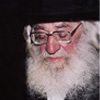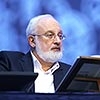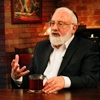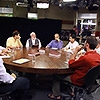Audio Version Of The Blog – 10/3/19
Listen to an Audio Version of the Blog
Download:MP3 Audio

Listen to an Audio Version of the Blog
Download:MP3 Audio
 From My Facebook Page Michael Laitman 10/3/19
From My Facebook Page Michael Laitman 10/3/19
On a cold, rainy night in 1979, I could not sleep, my thoughts troubled me. Suddenly I found myself at the wheel, driving without direction. A large sign cut through my thoughts: “Bnei Brak.” I went in. The streets were deserted. At the corner of “Chazon Ish” Street I ran into a passerby. “Where do you study here?” I asked. He looked at me and answered, “Drive to the end of the street, where you will see an orchard. It’s on the other side of it.”
This is how I came to meet my teacher for the first time, Rabbi Baruch Shalom Ashlag (the Rabash), the eldest son and successor of Baal HaSulam – the greatest Kabbalist of the twentieth century. From that moment on my life was never the same.
For the next twelve years I served as his personal assistant and disciple, and I absorbed from him everything that I know in the wisdom of Kabbalah. Every day he would lock himself up on the second floor and write. This is how his profound articles were born, which paved the way for anyone nowadays to carve the spiritual path most suited to them. No one before him had written in such a simple and practical manner. Like a father who guides his children along the path, he takes his readers by the hand and guides them until they discover the true meaning of life.
“And once I have acquired the clothing of love,” he wrote to his students at the end of the well-known letter “Love of Friends,” “Sparks of love promptly begin to shine within me. The heart begins to long to unite with my friends, and it seems to me that my eyes see my friends, my ears hear their voices, my mouth speaks to them, the hands embrace, the feet dance in a circle, in love and joy together with them…” (the Rabash).
After his departure in 1991, people who felt a burning desire in their hearts to reveal their purpose started coming together. Gradually, the “Bnei Baruch” Kabbalah Education & Research Institute was formed, named after Kabbalist Baruch Ashlag. Every morning we study the writings of the Kabbalists, such as The Study of the Ten Sefirot, The Zohar with the Sulam commentary and the writings of Baal HaSulam and the Rabash. We work to share the method with anyone interested, just as my teacher gave me the wisdom of his father.
Today we mark the 28th anniversary of the passing of my teacher, the Rabash, the greatest of the generation. I hope that we will succeed in following his path faithfully.
 Today, on the day commemorating the anniversary of the death of our teacher, Kabbalist Rabbi Baruch Shalom Ashlag, the Rabash, we do not delve into memories. We place no special emphasis on death anniversary dates, as it is customary among those who are far from the truth. We simply relate to such days as signs in order to connect and adhere more, or at least, come closer to our root.
Today, on the day commemorating the anniversary of the death of our teacher, Kabbalist Rabbi Baruch Shalom Ashlag, the Rabash, we do not delve into memories. We place no special emphasis on death anniversary dates, as it is customary among those who are far from the truth. We simply relate to such days as signs in order to connect and adhere more, or at least, come closer to our root.
Why? It is because, who really is Rabash? Rabash is a certain extent of the Creator’s revelation toward us.
We would like to express our gratitude to the Creator for Rabash. He sent us a messenger through which we were given the opportunity to come closer to the Creator: to correct and adapt ourselves in equivalence of form with the upper force.
This is how we connect ourselves to Rabash and to the Creator.
Rabash is a degree between us and the Creator. We receive everything through Rabash, his entire spiritual ascent. Each person is created and exists through his friends and teacher, but Rabash truly emerges as a system. He reveals to us a form of connection with the Creator through which we truly realize ourselves and come closer to the truth.
First and foremost, we need to paint that picture to ourselves, that we’re not dealing with externalities, i.e. with a person’s habits and behaviors. We firstly need to see this specific revelation of the Creator toward us, that the Creator revealed Himself in this distinct manner.
Therefore, the more that we appreciate Rabash, the closer we come to the Creator.
We appreciate that degree of revelation He made for us through this particular higher force called “Rabash.” It became important to us. It connected and brought us closer to the Creator.
On this day, we will read excerpts discussing this topic. Also, we will try to accurately calibrate ourselves to that form, which became revealed in its externality to a certain extent, and afterward became concealed, i.e. departed.
Moreover, despite its departure, its purification, we need to elevate ourselves—to become purified by ourselves, arriving at a connection with that unique spiritual root, and seeing our higher degree in it. Through establishing such a connection with our higher degree, we can then further progress to the Creator.
Based on the Lesson on the topic of “Memorial Day for Rav Baruch Shalom Halevi Ashlag (Rabash)” – Oct. 3, 2019
Related Material:
Lesson on the topic of “Memorial Day for Rav Baruch Shalom Halevi Ashlag (Rabash)” – Oct. 3, 2019

The Times of Israel published my new article “The Fast of Gedaliah and How It Resonates In Contemporary Jewish Life”
The murder of Gedalia Ben Ahikam was the first political assassination where a Jew killed a Jew. This tragedy is commemorated on the day after Rosh Hashanah with the Fast of Gedaliah.
Most likely we have hardly heard about this personality, so why is it relevant to our lives as Jews? It is because it reminds us of the heavy price that we pay when we as a nation degenerate into extreme internal disputes.
How did this unfortunate event in Jewish history unfold and what is its deeper meaning?
The assassination took place in the locality of Mitzpa in the Judean Desert just 2,591 years ago. The kingdom of Judea was then under Babylonian occupation, the First Temple had been destroyed, and Nebuchadnezzar, king of Babylon, ruled the country. In those days, the Babylonians destroyed Jerusalem, exiled most of the Jewish nobility to Babylon (today’s Iraq), and concentrated in Judea the poor workers who remained so they would supply the soldiers with food.
Nebuchadnezzar appointed Gedaliah Ben Ahikam, the son of a respected family in Judea, as his High Commissioner. His role was to control the social order of the occupied minority that had remained as a sort of “Ambassador for Jewish Affairs.” Gedaliah was worried about the political entanglement that the kings of Babylon and Amon had worked out, but true to the advice of Jeremiah the prophet, the senior spiritual personality of the time, he settled in Mitzpa, west of Jerusalem, and assumed his role as the kingdom’s governor.
In less than two months, he managed to unite the remnants of the refugees of the destruction, rehabilitate the Jewish community, and life returned to its course. As a result, many Jews returned from neighboring countries, but none suspected the scheme that was being plotted under Gedaliah’s nose.
What was that scheme?
Ismael Ben Natanyah, a scion of the House of David, could not acquiesce to the fact that he was not chosen to rule Judea and was hoping to take over the reins in the country. Motivated by jealousy, he recruited a group of Jews, and together they conspired to eliminate Gedaliah. He joined forces with the King of Amon (today’s Jordan) who himself felt threatened by the renewed strength of the Jewish community headed by Gedaliah, and together they executed their malevolent plan on the eve of Rosh Hashanah.
In the midst of a festive meal hosted by Gedaliah for Ismael and his men, Ismael murdered Gedaliah the “traitor” and also massacred all of his supporters. Ismael, who had hoped to become the ruler, was met with strong opposition and rejection from the Jewish population, and became forced to escape and find refuge in Trans-Jordan. The residents of Judea, fearful of Babylonian revenge, fled to Egypt, and following them, the last remnants of the Jews immigrated to different countries and the Babylonian exile officially began.
The unfounded hatred that erupted in Judea cut short the hope of reconstruction and renewal. It brought about the last disintegration in Israeli society. It put an end to Jewish sovereignty in the Land of Israel and it ended the period of the First Temple: the symbol of unity and mutual guarantee. Since that day, it has been customary to mark the division that tore us apart and drove us out of the country as a day of fasting.
3,000 years have passed since then, and not a lot has changed in the 2019 model of the “Kingdom of Judea.” The people of Israel are divided into camps and tribes with different conceptions and viewpoints. Polarization and division are the order of the day. Any sort of leadership is met with derision, and unfounded hatred abounds. The Fast of Gedaliah that is commemorated the first day out of the ten days of repentance between Rosh Hashanah and Yom Kippur is a day of deep soul searching in which we should find out what can unite us as a people.
The more we deal with the natural elements of the people of Israel—unity, mutual guarantee and love of others—the sooner we will arrive at the realization that the reason for all suffering in our lives is the human ego: the negative force in nature. In order to counteract the ego, we need a positive force: the light of the Torah, which resides in our unity.
The murder of Gedaliah and the fast for its remembrance are a reminder, as Maimonides writes:
“There are days in which all of Israel torments themselves because of all the troubles that have occurred in them, in order to awaken the hearts and open ways of repentance. And it will serve to remind us of our bad deeds, and this memory we shall return to do good.”
[253618]
 When a point in the heart awakens in a person, one yearns for the Creator, but one does not yet feel like a separate part of the common system and does not seek to connect with others. However, gradually, under the influence of the reforming light, one begins to feel the need to connect with others; ultimately there is one soul and it shines equally to each and every one.
When a point in the heart awakens in a person, one yearns for the Creator, but one does not yet feel like a separate part of the common system and does not seek to connect with others. However, gradually, under the influence of the reforming light, one begins to feel the need to connect with others; ultimately there is one soul and it shines equally to each and every one.
One still needs to correct one’s perception of reality because a person feels the world totally differently from one’s shattered vessel. It seems to him that we all exist separately and that the world is divided into many parts, somehow connected with each other. Yet, you must see the world as one, as integral, that is, not connected by some kind of threads, but rather existing as one whole.
Even if we are connected to each other through the will to receive, the restriction, the screen, and the reflected light; in other words, even if we are connected through some kind of tubes, there must still be such a connection between us, as if there are no limitations in this connection through the tubes, the individual threads. These connecting pipes must fill the entire space, as if waves of the sea penetrate between us, connecting us without any barriers.
We will then turn into a single Kli, the way it was before the shattering, but through an infinite number of screens. The attitude to the will to receive will become corrected through the infinite number of individual acts of overcoming, and we will reach an integral and continuous connection.
The worldview from my ten’s perspective and from my individual perspective differ as if a perception of reality were created by the Creator and by me. I see the world in the form of separate pixels, in a black and white image.
The more pixels I distinguish, with more forms and colors, the clearer and deeper is my perception in all axes: past-present-future and I-the Creator-the common soul. However, all this is in binary form, in the contrast of light and darkness.
When we come closer to the state where darkness shines as light and light and darkness become as one whole for us, we should as if lose the ability to see anything in the old perception where everything was based on the difference, on the contrast between black and white.
The spiritual perception of reality, however, depends on how much I annul myself, eliminating the difference between light and darkness. I want darkness to shine as light in my senses, which is against my will to receive. I want to rise above it so that darkness will resemble my new desire armed with restriction, screen, and reflected light. I then reach the higher perception of reality, feeling it as the Creator. 1
From the 1st part of the Daily Kabbalah Lesson 9/16/19, Writing of Baal HaSulam, “600,000 Souls”
1 Minute 12:45
Related Material:
A Heart And A Point In The Heart
How Do You Develop A Point In The Heart?
Driven By Suffering, Curiosity, Or The Point In The Heart
 Question: Three years ago, I began studying Kabbalah and thought that I understood everything. Both the “Preface to the Wisdom of Kabbalah” (Pticha) and TES were really understandable and clear.
Question: Three years ago, I began studying Kabbalah and thought that I understood everything. Both the “Preface to the Wisdom of Kabbalah” (Pticha) and TES were really understandable and clear.
Now after three years, I’m beginning to feel that not only do I not understand what was clear before, but also, Pticha, TES, and work in the group evoke some disgust in me. Is this a normal sign?
Answer: This is a sign of good advancement. You must pass this period by force and persistence, and then you will begin to understand everything with both your mind and feelings.
Question: So, these disturbances are in fact helping?
Answer: Yes. But it can go on for quite a long time, maybe for a few years. The main thing is not to leave and you will see how it will be rewarded.
[251355]
From the Kabbalah Lesson in Russian 6/23/19
Related Material:
Obstacles Guide Us On The Way
Cure For Lethargy
Understanding The Language Of The Creator
 Question: What is required for the development of the soul? How does the process occur? How can you understand and feel that you are on the right path?
Question: What is required for the development of the soul? How does the process occur? How can you understand and feel that you are on the right path?
Answer: Only one thing is required for the development of the soul: to begin to develop it by drawing closer to others. For this, we usually build small groups that we call “tens” because it is desirable that the group is comprised of ten people, but it can be fewer than ten. By drawing closer to each other in the ten, people begin to feel certain spiritual laws that operate within it.
This is a very interesting state. We can make of ourselves a laboratory in which we will feel ourselves under the influence of a special force, or the Creator.
In other words, as we start drawing closer to each other, we begin to feel how the Creator manifests between us, and as we move away from each other we feel how He distances from us. The Creator is in the center of this small group, and this is how we can define, clarify, and reveal Him. This state does not come immediately, we need to approach it. Give it a try.
By building the connection between us in spite of the egoistic forces that push us away, we will begin to feel it. It is the rapprochement above rejection that will cause a certain sense of the revelation of something in us. This “something” will be the harbinger of the attainment of the Creator. It is quite complicated and doesn’t come immediately, but it is precisely what our workshop is in practice.
[251399]
From the Kabbalah Lesson in Russian 7/7/19
Related Material:
How The Soul Is Developed
A Vessel For The Soul
Finding Your Soul
Lesson Preparation
| [media 1] | [media 2] |
Lesson on the Topic “Memorial Day for Rav Baruch Shalom Halevi Ashlag (Rabash)”
| [media 3] | [media 4] |